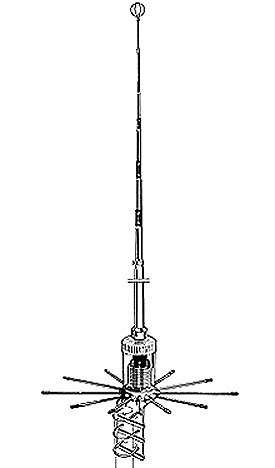
![]() THE HALF
WAVE VERTICAL (GPA)------
THE 5/8 WAVE VERTICAL-------- MOBILE ANTENNA
THE HALF
WAVE VERTICAL (GPA)------
THE 5/8 WAVE VERTICAL-------- MOBILE ANTENNA

The vertical
antenna is as we know it is an omni directional antenna, this means
that its radiating field is in all directions equal.
On the 11 meter band we can come across various types:
the mobile antenna
the 1/4 wl vertical
the 1/2 wl vertical
the 5/8 wl vertical
the 3/4 wl vertical
All these antennas have there own capabilities. And there are many variants
within those mentioned above. Luckily we can bring all back to the basic.
First we
will get ride of some misunderstandings:
It is just not possible that a 5/8 wave vertical is several S-units
stronger then a half wave. (in local conversations) The person who thinks
this was the case with him, has probably have to take a look for an
answer in a other direction say..height, new coax, perhaps the connectors
are connected now correct, in the worst case the receiving S-needle
is just way to optimistic.
It is possible from time to time in DXing situations but this is only
due to different take-off angles.
The Gain produced by a half-wave vertical(Antron 99/Bandit etc) is nothing
over a Dipole. Because it is a Dipole., all stories with gain (11dBI
etc...) not true!
The Gain produced by a 5/8 wave vertical is about 1,5 dB over a Dipole.
anything else is not true!
Overall, there is no different between antennas with the same length
except diameter, price, how the antenna is made resonant (SWR). But
the electrical capabilities are all the same!
With antennas longer then 5/8 wavelength, the DX results will go down.
The reason for this is that the bundle of radiation brakes up in to
several smaller bundles.
There are stories going around in which is mentioned that you must aim
the coil in the direction in which you would like the strongest signal,
this is not true. It does not matter on which side of the mast you mount
the vertical. (Not included dipoles on the side of the mast)
THE
ADVANTAGE
A vertical antenna has a very low radiation pattern from its own and
does not depend on height as much as a horizontal antenna does (over
good ground).
And a vertical antenna is often omni-directional, so extra cost with
rotators do not come in.
By going through the site you can learn how the take-off angle is of
influence and at what height a horizontal antenna might be better for
you.
The low take-off angle is the advantage where DX-expeditions take effort
from. But only over good ground this is the case (water, grass etc.)
above industrial ground or desert ground this advantage does not exist!
THE
DISADVANTAGE
I keep hearing of all the noise stories on the vertical antenna, this
just might cause u did not hear that station calling.
The gain (when u do not want to change that omni-directional pattern)
is very marginal.
A vertical can cause TVI or any other for of interference at the neighbors
this compared to a horizontal one.
All in one the vertical has it pluses and minuses but definitely will
never be of the playground when people started looking for an antenna
for their purpose.
A very
interesting link: THE
IMAX 2000 EXPOSED
![]()